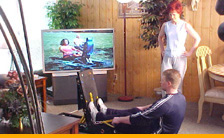Technology is great. It’s used across every industry to automate and expedite everything including manufacturing, construction, and delivering food from farm to table. It’s made life easier. So much easier, in fact, that it’s killing us–literally causing our bodies to atrophy and shutting down organs and cardiorespiratory systems. Some people have taken to a sedentary lifestyle readily, but if you get antsy after sitting for several hours straight that’s probably your body remembering that it was made to move. There is a lot of advice on how much exercise people need to stay healthy or lose weight, but it turns out that there isn’t a one-size-fits-all solution.
Why You Need to Exercise

Sitting hunched over your computer all day interferes with circulation, breathing, and doesn’t burn many calories.
Medical Daily details what happens to your body over time after hours, days, weeks, months, and years of sitting, sitting, sitting. Constant sitting affects your posture which, in turn, inhibits your lungs from expanding. Incomplete expansion means ineffective breathing which ultimately means insufficient oxygen getting into your body. Additionally, circulation slows down when you’re not moving, so less of your oxygen-depleted blood gets distributed throughout your body to organs and tissue. All of that results in poor physical health as well as diminished mental performance. Plus, people with sedentary lifestyles don’t tend to reduce their caloric intake to compensate for the calories they’re not using. Naturally, that results in weight gain which increases health risks and aggravates the ones already present.
Get Moving!

Traditional exercise doesn’t interest you? Go bowling, golfing, or play tennis. Anything that gets you moving is beneficial.
The answer is as simple as it is obvious: if sitting is killing you, getting active will save your life. In an effort to do the bare minimum of activity that is required to remain somewhat healthy and possibly lose weight, many constantly ask the question, “How much exercise do I really need?” Thrilled that people are even considering activity as an alternative lifestyle, the government published guidelines that give general recommendations for various age groups. Healthy adults, for instance, are advised to get 75 to 90 minutes of moderate to intense physical activity each week, along with at least two sessions of resistance training. The unfortunate fact is, however, that advice won’t necessarily work for everyone. Some jobs require more sitting and less activity than others so, logically, some people may require more movement to offset the negative effects of their extra-sedentary lifestyle.
A Winning Formula

With home exercise equipment, you can spend your time in front of the TV working out instead of vegging out.
Harvard Health notes that any activity is better than none at all, so if all you can fit into your schedule is the recommended minimum, do it! However, if you want to get as much exercise as you really need, a recent study reveals a formula for determining how much exercise your body requires based on how many hours per day you’re sedentary. The Lancet-published study reveals different exercise-to-sitting time ratios, and that includes hours spent sitting while watching TV. For example, someone who spends their entire eight-hour workday sitting should get at least one full hour of exercise. If you add on two hours or more of television at night, you need to tack on anywhere from 15 to 30 additional minutes to compensate, a rough estimate based on the study’s recommended 8:60 and 6:30 sitting-hours-to-exercise-minutes ratio. Of course, you could jump rope, jog on the treadmill, or lift weights while watching the boob-tube. It’s a win-win that puts those TV-watching hours in the exercise column instead of on the sitting side. The bonus is that it will help you get enough movement to start getting healthy again and even lose weight in the process.
The Really, Really Good News

Take a walk on your breaks during work, or take the dog for a walk after dinner–it all adds up and contributes to your total exercise minutes.
Before you stress out about trying to fit a full hour of exercise into your already jam-packed day, remember that you don’t need to exercise for 60 minutes straight to make it count. Back in 2012, researchers found that breaking up exercise into small 10-minute increments did not reduce the positive benefits. So here’s how your hour of exercise each day can go down:
- Use morning and afternoon breaks at work to take a brisk 10 to 15-minute walk.
- Spend 20 minutes on a cardio machine or doing aerobics before or after work, whenever it’s most convenient.
- Take a 10 to 20-minute walk after dinner instead of vegging out in front of the TV or computer–or at least before vegging out.
A couple of times a week, you can replace your daytime walks or your evening walk with a resistance training session. Perform it as a HIIT workout to get both resistance and cardio at the same time to maximize benefits.
